service ASTON MARTIN DB AR1 Q 2003 Owners Guide
[x] Cancel search | Manufacturer: ASTON MARTIN, Model Year: 2003, Model line: DB AR1 Q, Model: ASTON MARTIN DB AR1 Q 2003Pages: 279, PDF Size: 3.77 MB
Page 5 of 279
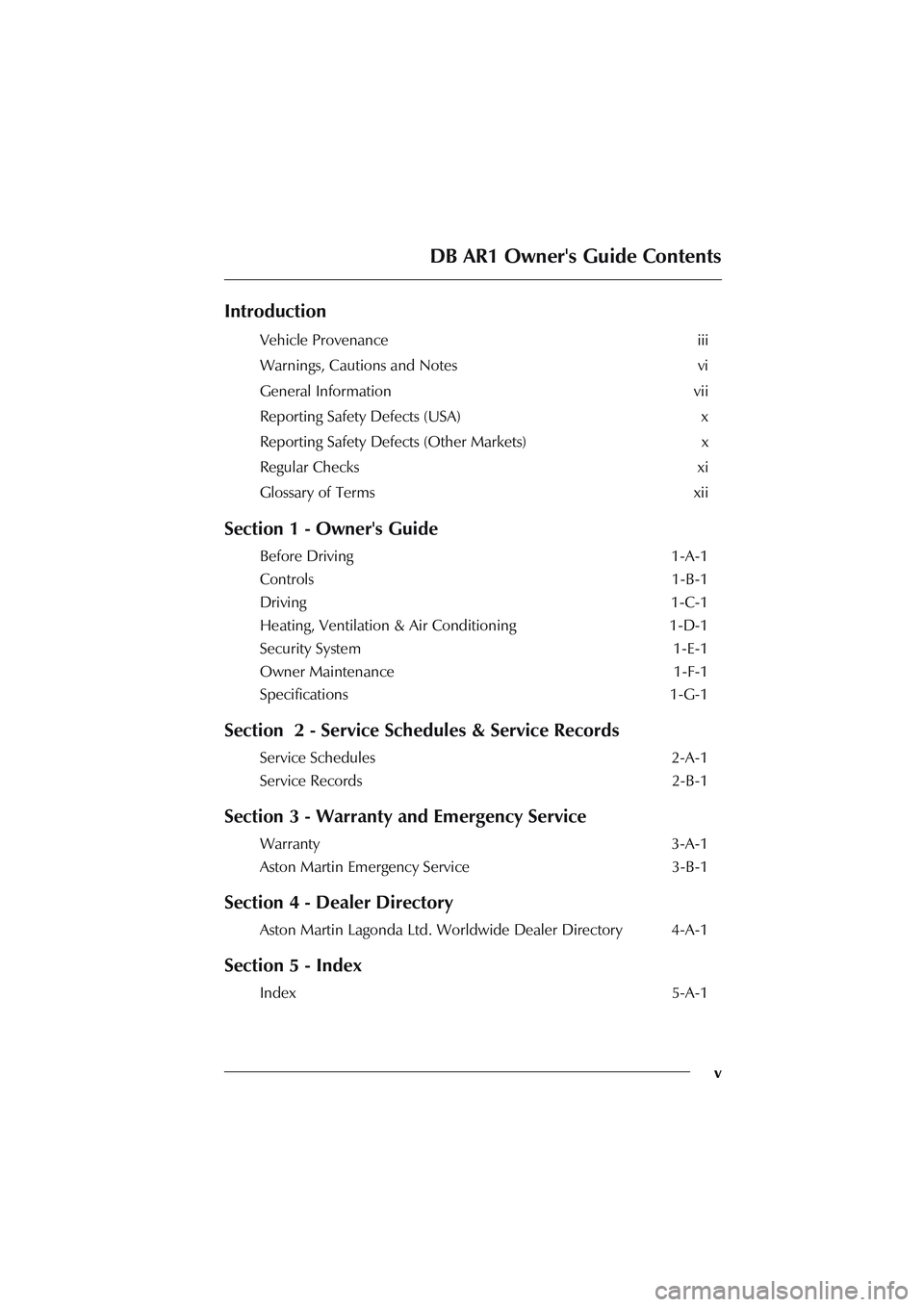
v
DB AR1 Owner's Guide Contents
Introduction
Vehicle Provenance iii
Warnings, Cautions and Notes vi
General Information vii
Reporting Safety Defects (USA) x
Reporting Safety Defects (Other Markets) x
Regular Checks xi
Glossary of Terms xii
Section 1 - Owner's Guide
Before Driving 1-A-1
Controls 1-B-1
Driving 1-C-1
Heating, Ventilation & Air Conditioning 1-D-1
Security System 1-E-1
Owner Maintenance 1-F-1
Specifications 1-G-1
Section 2 - Service Schedules & Service Records
Service Schedules 2-A-1
Service Records 2-B-1
Section 3 - Warranty and Emergency Service
Warranty 3-A-1
Aston Martin Emergency Service 3-B-1
Section 4 - Dealer Directory
Aston Martin Lagonda Ltd. Worldwide Dealer Directory 4-A-1
Section 5 - Index
Index 5-A-1
Page 7 of 279
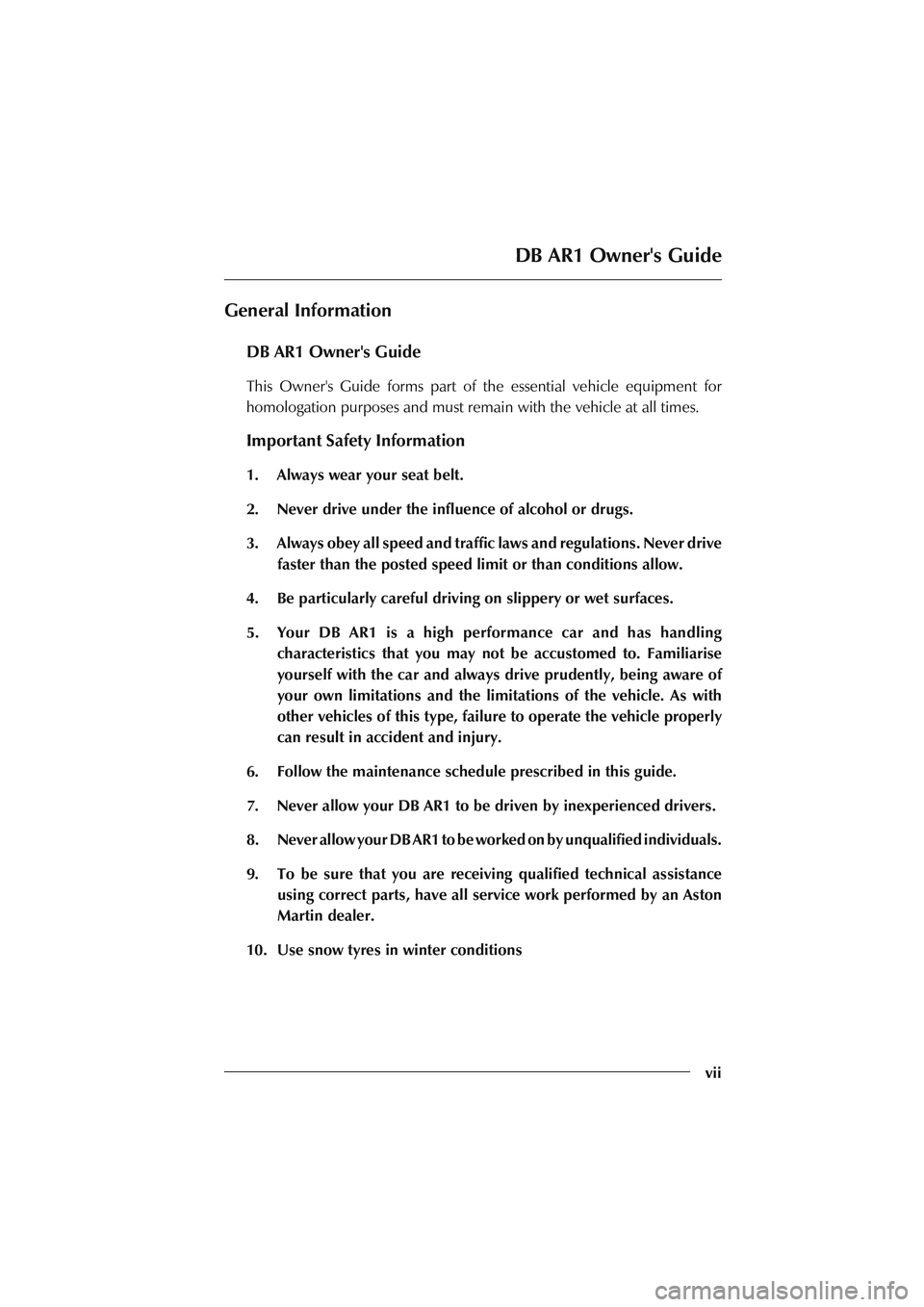
vii
General Information
DB AR1 Owner's Guide
This Owner's Guide forms part of the essential vehicle equipment for
homologation purposes and must remain with the vehicle at all times.
Important Safety Information
1. Always wear your seat belt.
2. Never drive under the influence of alcohol or drugs.
3. Always obey all speed and traffic laws and regulations. Never drive
faster than the posted speed limit or than conditions allow.
4. Be particularly careful driving on slippery or wet surfaces.
5. Your DB AR1 is a high performance car and has handling
characteristics that you may not be accustomed to. Familiarise
yourself with the car and always drive prudently, being aware of
your own limitations and the limitations of the vehicle. As with
other vehicles of this type, failure to operate the vehicle properly
can result in accident and injury.
6. Follow the maintenance schedule prescribed in this guide.
7. Never allow your DB AR1 to be driven by inexperienced drivers.
8. Never allow your DB AR1 to be worked on by unqualified individuals.
9. To be sure that you are receiving qualified technical assistance
using correct parts, have all service work performed by an Aston
Martin dealer.
10. Use snow tyres in winter conditions
DB AR1 Owner's Guide
Page 8 of 279
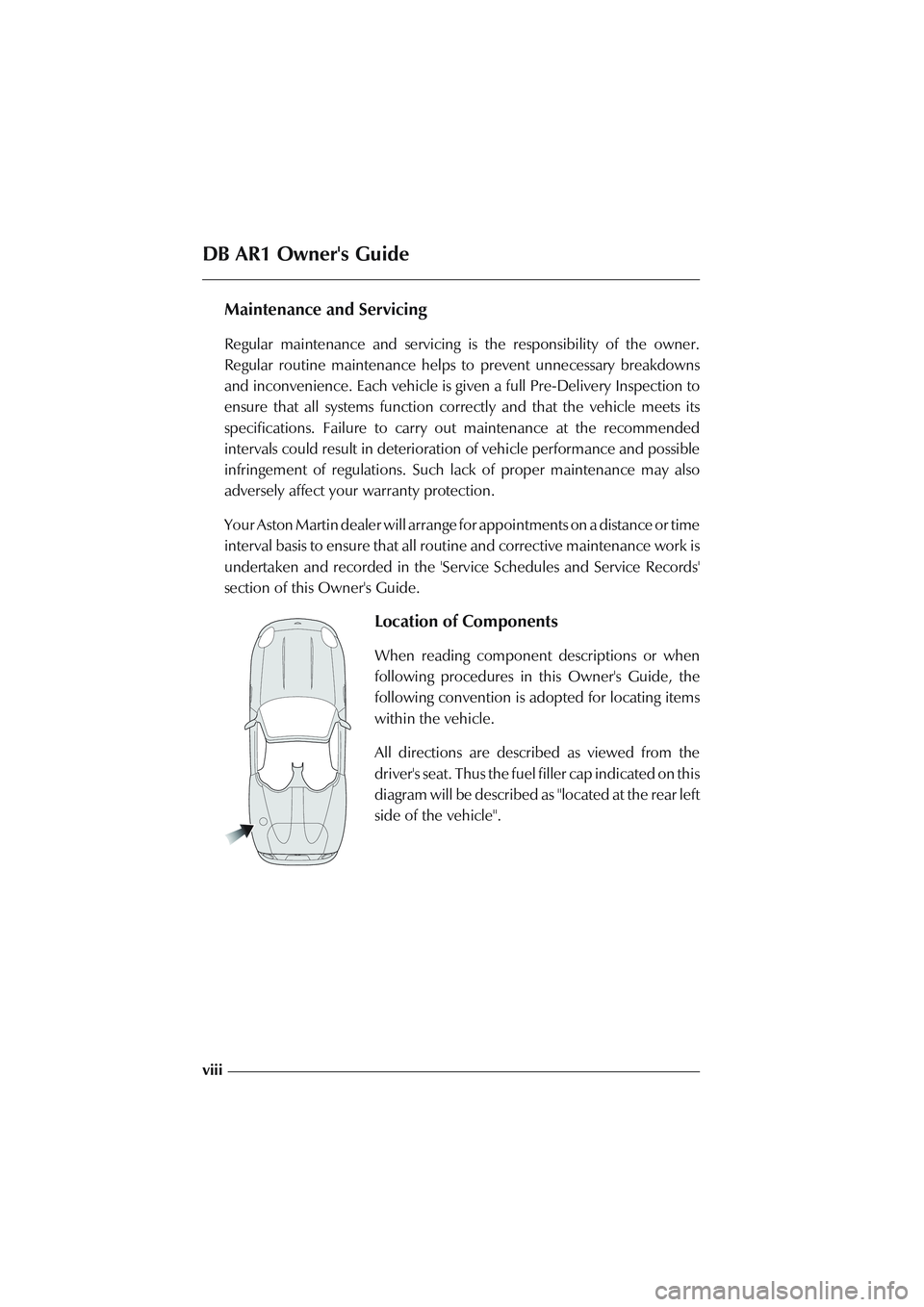
viii
Maintenance and Servicing
Regular maintenance and servicing is the responsibility of the owner.
Regular routine maintenance helps to prevent unnecessary breakdowns
and inconvenience. Each vehicle is given a full Pre-Delivery Inspection to
ensure that all systems function correctly and that the vehicle meets its
specifications. Failure to carry out maintenance at the recommended
intervals could result in deterioration of vehicle performance and possible
infringement of regulations. Such lack of proper maintenance may also
adversely affect your warranty protection.
Your Aston Martin dealer will arrange for appointments on a distance or time
interval basis to ensure that all routine and corrective maintenance work is
undertaken and recorded in the 'Service Schedules and Service Records'
section of this Owner's Guide.
Location of Components
When reading component descriptions or when
following procedures in this Owner's Guide, the
following convention is adopted for locating items
within the vehicle.
All directions are described as viewed from the
driver's seat. Thus the fuel filler cap indicated on this
diagram will be described as "located at the rear left
side of the vehicle".
DB AR1 Owner's Guide
Page 10 of 279
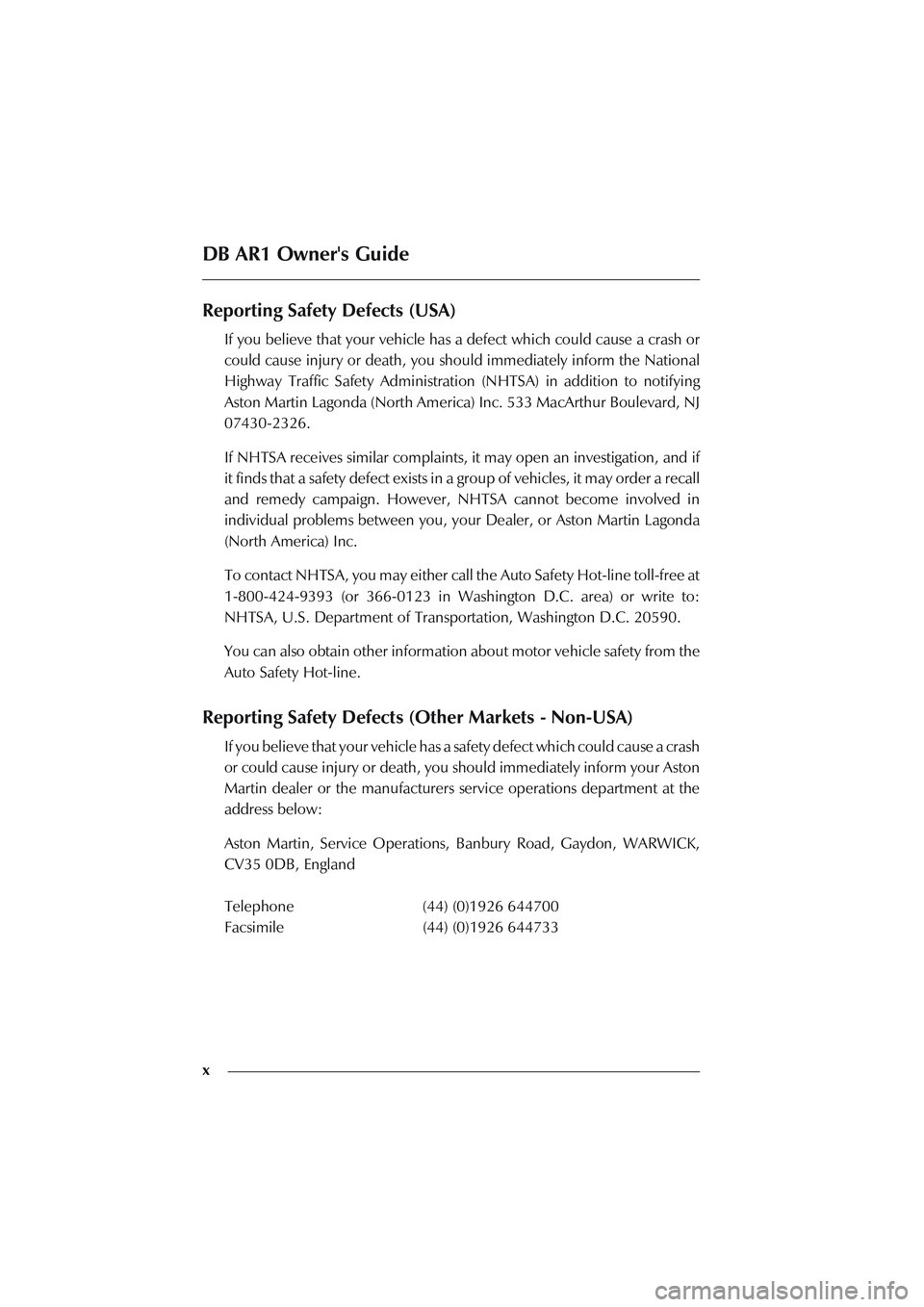
x
Reporting Safety Defects (USA)
If you believe that your vehicle has a defect which could cause a crash or
could cause injury or death, you should immediately inform the National
Highway Traffic Safety Administration (NHTSA) in addition to notifying
Aston Martin Lagonda (North America) Inc. 533 MacArthur Boulevard, NJ
07430-2326.
If NHTSA receives similar complaints, it may open an investigation, and if
it finds that a safety defect exists in a group of vehicles, it may order a recall
and remedy campaign. However, NHTSA cannot become involved in
individual problems between you, your Dealer, or Aston Martin Lagonda
(North America) Inc.
To contact NHTSA, you may either call the Auto Safety Hot-line toll-free at
1-800-424-9393 (or 366-0123 in Washington D.C. area) or write to:
NHTSA, U.S. Department of Transportation, Washington D.C. 20590.
You can also obtain other information about motor vehicle safety from the
Auto Safety Hot-line.
Reporting Safety Defects (Other Markets - Non-USA)
If you believe that your vehicle has a safety defect which could cause a crash
or could cause injury or death, you should immediately inform your Aston
Martin dealer or the manufacturers service operations department at the
address below:
Aston Martin, Service Operations, Banbury Road, Gaydon, WARWICK,
CV35 0DB, England
Telephone (44) (0)1926 644700
Facsimile (44) (0)1926 644733
DB AR1 Owner's Guide
Page 111 of 279

F - Owner Maintenance
1-F-2
Introduction
Owner Maintenance
Each item in the Service Schedules must be performed on time as failure to
do so may void the New Car Warranty or other warranties. It is the owner's
responsibility to see that the vehicle is maintained properly and in accordance
with the manufacturer's service schedules.
Due to the sophistication of the various systems and the specialised
equipment required to maintain the DB AR1, owner maintenance should
be restricted to the routine procedures given in this Owner's Guide. If you
think that the car is not functioning properly, please return it to an Aston
Martin Dealer to be checked professionally.
Electronic Fuel Injection
WARNING: Electronic Fuel Injection: If the fuel system is allowed to run dry
irreparable damage to the fuel pumps may occur.
The electronic fuel injection system requires special equipment and test
facilities to set up and maintain so that the car gives maximum performance
coupled with economy and reliability. You are, therefore, strongly advised
to entrust all service work to an Aston Martin dealer.
WARNING: Any modifications/additions to the fuel system not specifically
designed by Aston Martin are prohibited. If done, they may cause damage to the
fuel system which in some circumstances could result in fire. It is recommended
that all Service Field Actions are entrusted to an Aston Martin dealer.
Page 112 of 279

F - Owner Maintenance
1-F-3
Parts and Lubricants
When undertaking a warranty servicing task, only parts, materials,
lubricants etc. that are specifically recommended by Aston Martin
Lagonda Limited should be used. Failure to do so can result in
damage to the vehicle and invalidate the New Car Warranty or
other warranties. Recommended lubricants, capacities, etc. may be
found in the Specifications section of this Owner's Guide, and are
recommended for use at all routine services whether or not under
warranty.
Emissions Warranty
The emission control systems fitted to cars for certain markets are
covered by a separate emissions warranty. A statement of the provisions
is given in the Warranty section of this Owner's Guide. You are
advised to familiarise yourself with all warranty conditions prior to
taking delivery of your car.
Engine Compartment Covers
The primary fluid level checks and reservoirs within the engine
compartment are all immediately accessible. The less frequently
maintained items are located under the engine compartment side
covers. To remove the covers, use a coin or the tool kit screwdriver
to turn the cover fasteners a quarter turn anti-clockwise. The fasteners
will pop-up and the covers can then be lifted off, along with a
rubber protection strip.
When replacing the covers, fit them into place and secure by pushing
down on each fastener and turn it a quarter turn clockwise until it
locks, then insert the rubber protection strip.
Page 123 of 279

F - Owner Maintenance
1-F-14
Tyre Pressures
In the interest of safety and tyre life it is important that correct tyre pressures
are carefully maintained (See 'Specifications').
Road holding, steering and braking are especially vulnerable to incorrect
tyre pressures.
Pressures increase slightly when tyres are hot and, for an accurate reading,
pressures should be checked when the tyres are cold.
After checking the pressures ensure that the valve caps are securely replaced
to provide an additional air seal and to prevent the ingress of dirt.
Running-In New Tyres
When new tyres have been fitted, speed should be limited, particularly
during the first 80 km (50 miles) or so of driving. Fast cornering, hard braking,
and harsh acceleration should also be avoided during this period.
Tyre Service
Tyres should be examined at regular intervals for wear and damage. Stones
or other objects which have become lodged in the tyre treads should be
carefully removed.
When new tyres are required, it is advisable to consult an Aston Martin
dealer who will be able to supply tyres to the correct specification.
Page 125 of 279
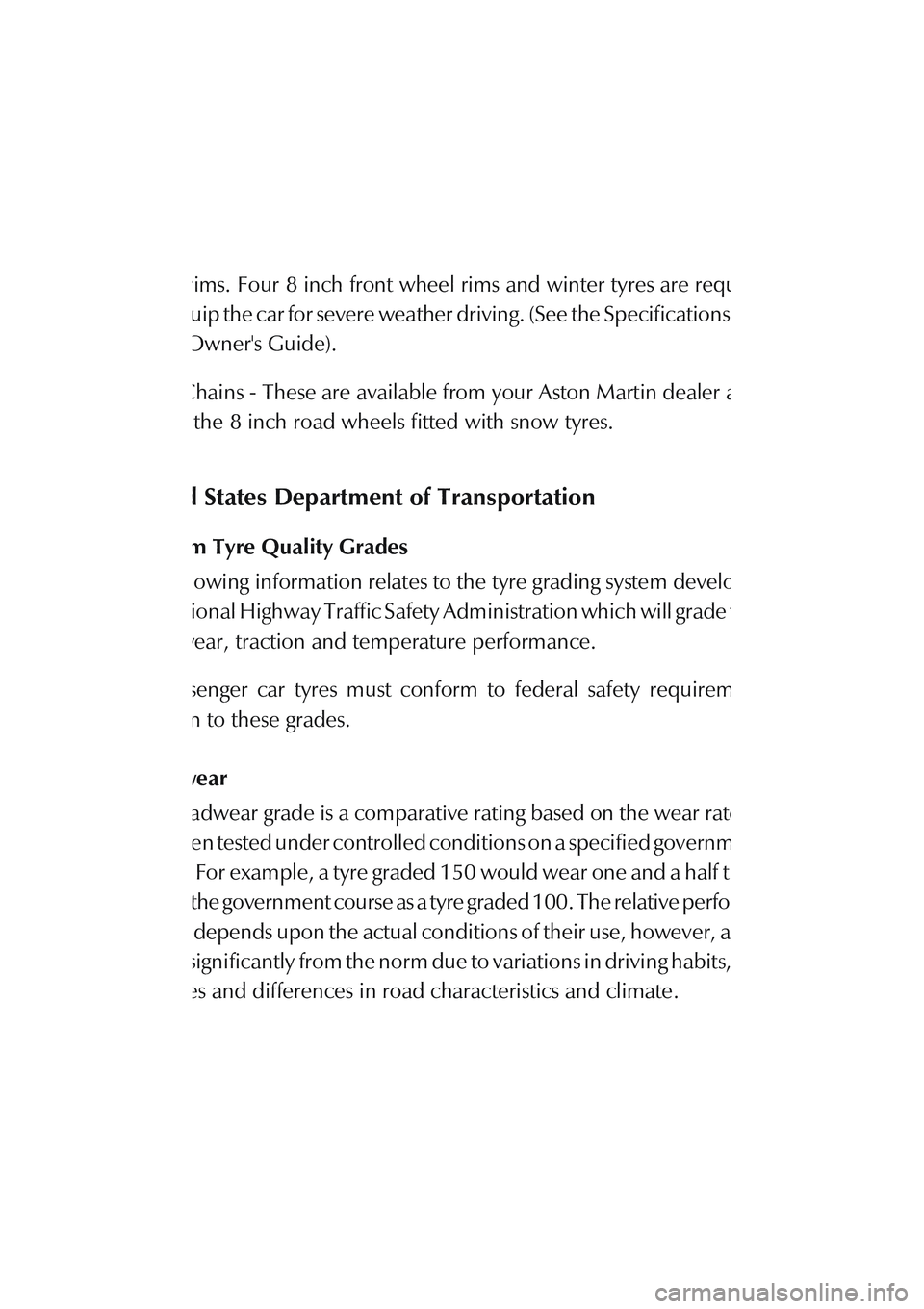
F - Owner Maintenance
1-F-16
Winter Tyres
Two options are available to equip your DB AR1 for winter motoring.
Snow Tyres - The recommended snow tyres fit to the normal 8 inch front
wheel rims. Four 8 inch front wheel rims and winter tyres are required to
fully equip the car for severe weather driving. (See the Specifications section
of this Owner's Guide).
Snow Chains - These are available from your Aston Martin dealer and will
fit only the 8 inch road wheels fitted with snow tyres.
United States Department of Transportation
Uniform Tyre Quality Grades
The following information relates to the tyre grading system developed by
the National Highway Traffic Safety Administration which will grade tyres by
tread wear, traction and temperature performance.
All passenger car tyres must conform to federal safety requirements in
addition to these grades.
Treadwear
The treadwear grade is a comparative rating based on the wear rate of the
tyre when tested under controlled conditions on a specified government test
course. For example, a tyre graded 150 would wear one and a half times as
well on the government course as a tyre graded 100. The relative performance
of tyres depends upon the actual conditions of their use, however, and may
depart significantly from the norm due to variations in driving habits, service
practices and differences in road characteristics and climate.
Page 130 of 279

F - Owner Maintenance
1-F-21 3. Firmly screw the aerosol to the valve of the punctured tyre. Remove the
cap from the canister. Holding the canister upright, press the button until
the contents of the can are completely emptied into the punctured tyre.
This may take up to 5 minutes per canister.
4. Repeat step 3 with the second canister.
WARNING: Because of the large air volume contained in tyres fitted to the
vehicle, two canisters are required to provide reinflation of a deflated tyre to
a safe working pressure.
5. Fit the 30 mph maximum speed WARNING labels to the repaired wheel
and to the steering wheel. Remove the steering wheel label only when
a new replacement tyre has been fitted.
6. Drive off immediately for 10 - 20 km (6 - 12 miles) at a maximum speed
of 50 km/h (30 mph) to allow the tyre weld product to spread within the
tyre.
7. Stop off the road in a safe place and visually inspect the tyre to confirm
that the leak has been completely sealed. Measure the tyre pressure
(pressure gauge in the tool kit) and if necessary drive to the nearest
service station and adjust to the correct pressure using an air line.
8. Limit your speed to 50 km/h (30 mph) and have the defective tyre and
valve replaced as soon as possible.
9. Purchase approved replacement aerosols and labels from your nearest
Aston Martin dealer as soon as possible.
Page 133 of 279

F - Owner Maintenance
1-F-24
5. Using the handwheel (A) on the jack screwshaft, raise the jack until the
jack top plate (B) fits to the jacking point stud under the sill at the affected
wheel. Ensure that the jack baseplate is squarely seated on solid ground.
Note: In the following step, the jack handle extension (D) must be used to prevent
damage to the vehicle paintwork as the jack handle (C) is rotated.
6. Ensure the safety of any persons in the vicinity and the security of the
wheel chock. Raise the vehicle as necessary using the jack ratchet handle
(C) and extension (D) to lift the deflated wheel clear of the ground.
Remove the wheel nuts and remove the deflated wheel.
7. Mount the spare wheel on the hub. Reverse the jack ratchet handle on
the extension and partially tighten the wheel nuts.
8. Lower the vehicle to the ground. Tighten the wheel nuts alternately.
Remove the wheel chock.
9. Repack the tools into their location in the boot. Place the defective wheel
into the bag provided and place on the rear seats.
10. When the spare wheel is correctly fitted and secured, drive conservatively
(80 km/h (50 mph) maximum) and have the wheel nuts torque tightened
to 88-102 Nm (65-75 lbs/ft) at the earliest opportunity.
WARNINGS:
Follow the wheel label warnings. Failure to comply can be dangerous. Drive
cautiously and refit a serviceable standard wheel and tyre as soon as possible.
Never fit more than one temporary spare wheel at a time.
Check that the temporary spare tyre is inflated to the specified pressure.
Never exceed 80 km/h (50 mph) when the spare wheel is fitted.